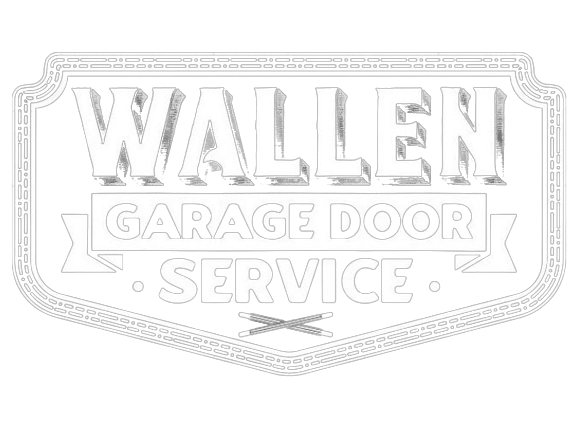Knowing about types of garage door springs is important because they help your garage door work well and last longer. These springs hold up the door’s weight as it moves, which affects how smoothly it operates. Selecting the right spring for your garage door can improve how it works and make it safer by lowering the chances of it suddenly breaking. In this guide, we’ll go over the types of garage door springs and why choosing the right one matters for your garage door’s performance.
Choosing the right type of spring for your garage door is not just about convenience; it’s about safety too. An improperly sized or worn-out spring can lead to malfunctions, such as the door becoming stuck or suddenly dropping unexpectedly. This not only poses a risk to your property but also to anyone nearby.
Types of Garage Door Springs
Torsion Springs
Torsion springs are a common type used in garage doors, recognized for their robust performance and efficiency. These springs are typically mounted horizontally above the garage door opening. When the door is closed, the springs are wound tightly, storing mechanical energy. As you open the garage door, the springs unwind, releasing this energy to assist in lifting the door, making the opening process smoother and more balanced.
- Durability and Lifespan
Torsion springs are valued for their durability and longevity. The lifespan of a torsion spring generally ranges between 15,000 to 20,000 cycles, with one cycle being a single opening and closing of the garage door. The actual lifespan can vary based on factors like maintenance, the quality of the spring, and the frequency of garage door usage.
- Types of Torsion Springs
There are several types of torsion springs to cater to different garage door requirements and setups:
- Standard Torsion Springs: Most common in residential garage doors, these are usually installed on heavier, double-car doors.
- Early-Set Torsion Springs: Mounted in the middle of the torsion shaft, these are similar to standard springs but differ in the installation method and their adjustment mechanism.
- Steel Rolling Door Torsion Springs: These are used in commercial applications for roll-up doors. The springs are encased in the torsion barrel supporting the roll-up door.
- Torque Master: Torque master springs are integrated into a winding cone at the end of the spring and are typically hidden within the torsion shaft, providing a cleaner look and added safety features.
Understanding the specific types of garage door springs and their characteristics can help in making informed decisions about maintenance and replacements to ensure optimal performance and safety of your garage door system.
Extension Springs
Extension springs are essential components in many residential garage door systems. Unlike torsion springs that coil to store energy, extension springs are installed along the horizontal tracks on each side of the garage door. They work by extending and contracting as the door opens and closes, which helps to counterbalance the weight of the door and facilitate smooth movement.
- Safety Measures
Due to the mechanism of extension springs, there is a higher risk associated with these springs if they break. This risk is primarily due to the potential for the spring to snap and cause injury or damage, as the energy stored within the spring is suddenly released. To mitigate these risks, it is crucial to incorporate safety cables. These cables run through the center of the springs and are secured to the wall or the ceiling at both ends. In the event of a spring breaking, the safety cables contain the broken spring, preventing it from causing damage or injury.
Regular maintenance and inspections are recommended to ensure the integrity and proper functioning of extension springs and their associated safety components. This preventive approach helps extend the lifespan of the springs and maintain the safety and efficiency of the garage door system.
TorqueMaster Springs
TorqueMaster springs are uniquely designed to be housed within the garage door’s shaft. This integration serves multiple purposes: it enhances the overall appearance of the door by concealing the springs, protects the springs from environmental damage, and prolongs their lifespan. The enclosed setup prevents dust, moisture, and other corrosive elements from impairing the spring’s function.
- How TorqueMaster Springs Work
The TorqueMaster system uses a winding bar and a specialized mechanism to adjust the tension of the springs safely and accurately. Unlike exposed springs that require manual handling with tools like wrenches and winding rods, the TorqueMaster’s internal mechanism can be adjusted with minimal risk, making it a safer and more user-friendly option.
- Enhanced Safety Features
The TorqueMaster spring system offers significant safety advantages. Traditional torsion springs are exposed and can pose serious risks if they snap, a common issue due to wear or improper maintenance. When a TorqueMaster spring fails, the breakage is contained within the shaft. This containment significantly reduces the chances of injury or damage to property, making TorqueMaster springs a safer choice for residential garage doors.
- Preventing Accidents
The design of the TorqueMaster spring system inherently prevents many of the accidents associated with conventional springs. Since the springs are not exposed, the risk of accidental injuries during manual adjustments is virtually eliminated. This feature is particularly beneficial in homes with children or pets, where interaction with garage door components might be more likely.
- Ease of Use and Maintenance
TorqueMaster springs are designed for ease of use and low maintenance. The internal mechanism allows for straightforward adjustments of the springs’ tension, which can be done without special tools or significant mechanical skills. This simplifies routine maintenance tasks like balancing the garage door, which can often be a complex and risky job with traditional springs.
- Simplified Installation and Replacement
Installing or replacing a TorqueMaster spring system is less labor-intensive compared to traditional torsion springs. The compact and contained nature of the system reduces the complexity of the installation process. Homeowners can benefit from less downtime and potentially lower installation costs, as the process is faster and less cumbersome.
Understanding the different types of garage door springs, particularly the TorqueMaster system, provides valuable insights into the safety, convenience, and efficiency of modern garage door technology. With its integrated design, enhanced safety features, and ease of use, the TorqueMaster spring system stands out as an excellent choice for homeowners seeking a reliable and user-friendly solution for their garage door needs.
Choosing the Right Garage Door Spring: Essential Factors and Tips
Selecting the appropriate garage door spring is critical for the longevity and safe operation of your garage door. Given the variety of springs available, understanding the specific requirements of your garage door is crucial. Here we discuss key factors to consider when choosing a garage door spring and why professional installation is indispensable.
Factors to Consider When Selecting a Garage Door Spring
- Weight and Size of the Door: The weight and size of your garage door are the primary determinants of the type of spring system you need. Heavier and larger doors require springs with higher tension capacity to properly balance and lift the door. Incorrectly matched springs can lead to faster wear and tear and can compromise the door’s functionality.
- Usage Frequency: How often you use your garage door should also influence the type of spring you select. Doors that are operated more frequently need springs that are designed to withstand a higher number of cycles (a cycle is one full opening and closing of the door). Standard springs typically support around 10,000 cycles, but there are options available that can handle up to 100,000 cycles for more intensive use.
- Safety Features: Given the potential hazards associated with garage door spring failure, considering safety features is essential. Some modern springs, like the TorqueMaster or enclosed spring systems, offer enhanced safety by containing the spring within a steel tube. If a spring breaks, these features prevent it from snapping out and causing injury or damage.
Importance of Professional Installation
While it might be tempting to install or replace garage door springs on your own, professional installation is strongly recommended to ensure optimal performance and safety.
- Expert Assessment: A professional can provide an accurate assessment of your garage door’s specific needs. This includes determining the correct spring type and tension required based on door weight, size, and usage patterns.
- Precision and Safety: Installing garage door springs involves significant risk due to the high tension the springs are under. Professionals have the necessary tools and expertise to handle these components safely, minimizing the risk of accidents during installation.
- Guaranteed Performance: Proper installation by a professional not only ensures that the door operates smoothly but also extends the lifespan of both the springs and the garage door itself. Improperly installed springs can lead to uneven lifting, increased wear on the door opener, and, ultimately, premature failure of the system.
Choosing the right type of garage door spring and opting for professional installation are crucial steps to maintaining the functionality and safety of your garage door. Consider the weight and size of the door, frequency of use, and safety features when selecting a spring. Always entrust the installation to experienced professionals to ensure that your garage door operates reliably and safely for years to come.
Maintenance and Safety Tips for Garage Door Springs
Proper maintenance and regular safety checks are key to extending the lifespan of garage door springs and ensuring they function safely and efficiently. Here, we will explore practical tips for routine maintenance and identify signs that indicate it’s time to consider replacing your garage door springs.
Routine Checks and Maintenance Tips
- Lubrication: Regularly lubricating the springs can prevent rust and reduce the friction that occurs when the door operates. Use a silicone-based lubricant specifically designed for garage door parts. Apply it every three to four months or as recommended in your garage door manual.
- Visual Inspection: Every few months, visually inspect the springs for signs of wear or damage, such as gaps in the spring coil or visible rust. Also, check for loose screws and worn pulleys and cables, which can affect the tension and balance of the door.
- Balance Test: Perform a balance test to ensure your garage door is properly aligned and evenly balanced. Disconnect the opener and manually lift the door halfway. A well-balanced door will stay in place, slightly moving up or down. If the door falls quickly or is hard to move, the springs might need adjustment or replacement.
- Professional Inspection: At least once a year, hire a professional to inspect and service your garage door system. They can identify issues that might not be apparent to untrained eyes and can ensure that all components are in optimal condition.
Signs of Wear and When to Consider Replacement
- Excessive Noise: If your garage door begins to make unusual sounds such as snapping, grinding, or squeaking, it could indicate that the springs are wearing out and need attention.
- Uneven Movement: Should the garage door start to open or close unevenly or jerk during movement, it might suggest that one of the springs is losing tension or has broken.
- Difficulty in Opening or Closing: Springs that are nearing the end of their life may struggle to bear the weight of the door, making it noticeably harder to open or close.
- Visible Damage: Any signs of physical damage, like stretched springs, or bent or broken coils, are clear indicators that the springs should be replaced immediately to avoid further damage or potential safety hazards.
Maintaining and routinely checking your garage door springs are crucial steps in ensuring the safety and longevity of your garage door system. By following these maintenance tips and keeping an eye out for signs of wear, you can help prevent accidents and costly repairs. Remember, while some maintenance can be done on your own, adjustments and replacements should be handled by professionals to ensure safety and efficiency.
FAQs on Types of Garage Door Springs
- What is the average lifespan of garage door springs?
Garage door springs typically last between 10,000 to 20,000 cycles, with one cycle being the garage door opening and closing once.
- How do I know if my garage door springs need to be replaced?
- The door is hard to open or close.
- The door does not move smoothly or makes loud noises.
- You see visible damage like stretched or broken springs.
- Can I replace garage door springs on my own?
Replacing garage door springs can be dangerous due to their high tension. It’s safer to hire a professional who has the right tools and knowledge.
- What are the safety risks associated with faulty garage door springs?
Faulty springs can cause the door to fall unexpectedly or operate unevenly, posing risks of injury or property damage. Attempting to replace springs yourself can also lead to injuries due to the springs’ tension.
- How much does it cost to replace garage door springs?
The cost to replace garage door springs generally ranges from $100 to $300, depending on the type of spring and the cost of labor in your area.
Conclusion
Understanding the different types of garage door springs and selecting the appropriate one for your needs is crucial for the functionality and longevity of your garage door. Each type of spring offers unique benefits and is suited to specific door weights and usage frequencies. Ensuring that you choose the right spring is essential for maintaining optimal performance and safety.
To guarantee the safety and efficiency of your garage door, it is advisable to consult with professionals for the installation and ongoing maintenance of your garage door springs. Professionals possess the necessary expertise and tools to properly handle the high-tension components of garage door systems, reducing the risk of injuries and malfunctions.
For residents of Hampton Roads, VA, “Wallen Garage Door Repair and Installation Services” stands out as a reliable provider of garage door solutions. With a commitment to offering expert advice and dependable service, Wallen Garage Door ensures that all your garage door needs are met with professionalism and precision. Trust Wallen Garage Door for expert installation, maintenance, and advice on the best types of garage door springs for your home, ensuring your door operates safely and efficiently for years to come.







